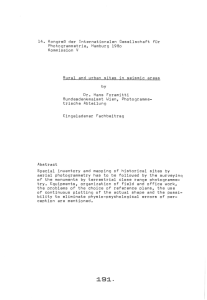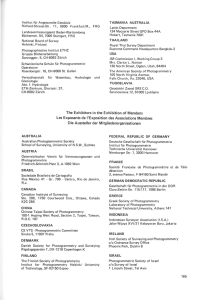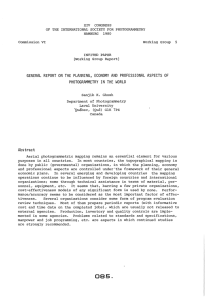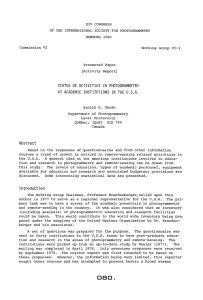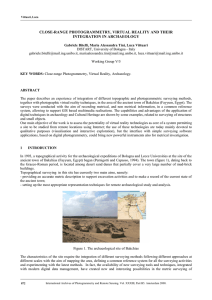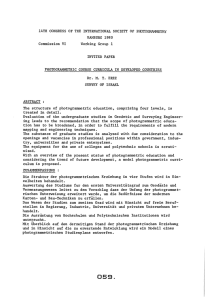WORKINGGROUP VI/I PER OLOF FAGERHOLM, DrTechn Stockholm
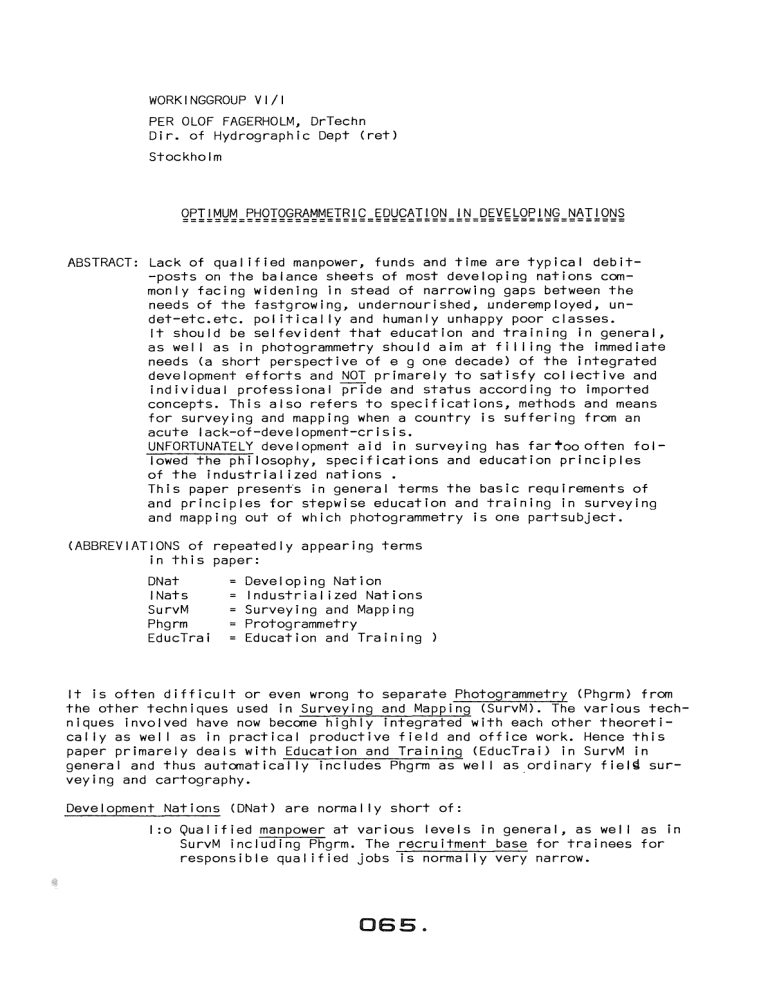
WORKINGGROUP VI/I
PER OLOF FAGERHOLM, DrTechn
Dir. of Hydrographic Dept (ret)
Stockholm
ABSTRACT: Lack of qualified manpower, funds and time are typical debit-
-posts on the balance sheets of most developing nations commonly facing widening in stead of narrowing gaps between the needs of the fastgrowing, undernourished, underemployed, undet-etc.etc. politically and humanly unhappy poor classes.
It should be selfevident that education and training in general, as wei I as in photogrammetry should aim at fi I I ing the immediate needs (a short perspective of e g one decade) of the integrated development efforts and NOT primarely to satisfy collective and individual professional pride and status according to imported concepts. This also refers to specifications, methods and means for surveying and mapping when a country is suffering from an acute lack-of-development-crisis.
UNFORTUNATELY development aid in surveying has fartoooften followed the philosophy, specifications and education principles of the industrialized nations .
This paper present's in general terms the basic requirements of and principles for stepwise education and training in surveying and mapping out of which photogrammetry is one partsubject.
(ABBREVIATIONS of repeatedly appearing terms in this paper:
DNat
INats
SurvM
Phgrm
EducTrai
=
Developing Nation
Industrialized Nations
Surveying and Mapping
Protogrammetry
Education and Training
It is often difficult or even wrong to separate Photogrammetry (Phgrm) from the other techniques used in Surveying and Mapping (SurvM). The various techniques involved have now become highly integrated with each other theoretically as wei I as in practical productive field and office work. Hence this paper primarely deals with Education and Training (EducTrai) in SurvM in general and thus automatically includes Phgrm as wei I as ordinary fielg surveying and cartography. ·
Development Nations (DNat) are normally short of:
I :o Qualified manpower at various levels in general, as wei I as in
SurvM including Phgrm. The recruitment base for trainees for responsible qualified jobs is normally very narrow.
065.
2:o Funds and especially foreign exchange.
3:o Time, as the needs of improvements are imminent and the pol itical patience short.
The development resources of a DNat- human as wei I as_material, includimg funds - wi I I therefor only become available for projects with a high priority. When setting those there are relevant and irrel ivant, objective and subjective, unselfish and selfish etc factors involved. But generally spoken, a high priority is more I ikely for projects giving early results beneficial to the big poor masses and for projects aiming at spectacular results.
SurvM , as such, does not fit into any of these two categories!
SurvM in DNats must, in this context, be divided into two groups: l:o Nationwide regular mapping which is a prerequisite for a rational long-term planning and for an efficient administration.
2:o Project mapping which is needed for designing specific technical projects I ike dams and irrigation schemes, roads, towns, boundary surveys of arable land etc.
Because of the time shortage common for most project mapping it is often carried out by foreign contractors. Nationwide regular mapping, on the other hand, is normally too costly and too time-expanded ( a 25 - 75 years perspective is common ) to be contracted out. And such national mapping seldomly receives any high priority and consequently no or unsufficient funds.
Project mapping contracts often include paragraphs about transfer of know-
-how through the participation by nationals in the contractor~s operations and paragraphs about tel lowships (or similar) for training at a foreign university or at the home office of the contractor where e g the photogrammetric office work normally is carried out. Such arrangements have normally not been very successful for a number of reasons. Transfer of know-how and efficiency-attitudes is only functioning if the "receiver" is of the right pushing type of man with enough professional education and experience to assimilate what is useful and a position high enough in his own organisation to implement what he has experienced. People with those qualifications and such a position normally prefer to visit the field only for short periods and if sent abroad there are many distractions within or outside the profession. Theoretical studies of satel I ita-triangulation may e g have very I ittle impact on the surveys for urgent development projects.
It was early realized in the multi lateral and bilateral aid activities that the lack of adequate maps seriously hampered the national development efforts. It was also found essential that at least a part of the project mapping should be carried out with national survey resources. Hence considerable technical assistance - funds, instruments and other equ•ipment and experts- were allotted to several DNats for building upanational survey capacity and educate and train national survey personnel. For various reasons only few of those projects resulted in efficiently working organisations. Project duration was often too short, especially for the foreign advisory or managing staff of experts. The best nationals were commonly sent abroad on year-long tel lowships during the most intens project period when they really should have been deeply involved in the project and learn a lot, not only technicalities, from the teamwork with experts/advisors.
Frequent changes in the national staff according to obsolete promotion principles and a fast advancing bureaucracy may be some of the common causes.
066.
One of the main causes for the less successful EducTrai results has commonly been the mistake of more or less copying survey methods, syl Iabus etc from the INats SurvM educational institutions. Those train surveyors for much more varied tasks and in the ~Nat we can afford a less job-oriented
EducTrai and involve theory for its own and for prestige sake. The studentmaterial in the DNats is far less homogene and they have often considerable white spots in their basic and fundamental education. !Nat-type of survey courses are often very difficult for the students to understand and if they learn it by heart (memorize it) in order to pass the examinations many of them never digest it.
The EducTrai must aim at producing surveyors etc able to carry out productive work soonest after completed school-period. Then he wi I I never - in any case before he has forgotten the more sophisticated theories he may have learnt - find time or reasons to use them. Therefor the first of the school-periods should be concentrated on th~ methods and means really used in the country. Later on more theoretical training should be given a minor group of such surveyors which show intelectual aptitude for it. Those wi I I later be responsible for future developments etc. but first and foremost the mapping activities must run smoothly and have enough staff competent to use efficiently and correctly the standard methods and means.
When composing the syl Iabus for job-oriented EducTrai in SurvM the modern techniques with "black boxes", ready made computer software or even programs for pocket size calculators allows for the exclusion of a lot of complicated theory when educating productive surveors, stereooperators etc.
On the other hand there are som~fairly simple traditional survey methods which sometimes are useful for minor and odd surveys. Both in the simple theory and in practice they give the student a good and easily understood introduction in SurvM. This refers to the basic field survey methods and e g to the orientation of and plotting from an independant stereomodel. It must also be remembered that modern survey means are very expensive and certainly wi I I be in short supply in the DNats. But they should definitely be used in the qualified parts of a survey and it is there where you earlier had the needs for theoretically educated surveyors, theories which now are automatically handled by computers etc. An "average" surveyor using e g a
Distomat need not know anything about what goes on inside the "box". A supervisor in the photogrammetry room need no knowledge of least square adjustment when carrying out a block-triangulation. We must make a clear distinction between what is a prerequisite for the job and what is interesting for the individ to know. In the long run it is important to help staff to develop their minds and deepen their knowledge. Thqt raises the standards and strengthens their selfesteem. But in an intens development period with shortage of resources it would be a luxury to use part of the resources for wider and higher education than needed for the urgent production. Certainly the opposite opinion wi I I be aired but then they wi I I have to tel I us where to cut in the production of the needed surveys and maps.
With some hesitation it is also pointed out that the higher theoretical education a group of persons is given, the higher are their salary demands and their expectations on service etc. In DNats the fieldsurveyor encounters a lot of hardship and if he feels that he is overqualified for the very important but technically rather simple fieldwork he wi I I not be so positive to fieldwork and try various tricks to become an office surveyor. You wi I I often find hughe office staffs - an excel lent grow~round for bureaucracy.
067.
It is n.ot possible, however, just to train people for specific positions on various levels and then leave them there "for ever". Of course there must be promotion possibi I ities and the promotions must be guided by the ski I I and aptitude for higher responsibi I ities. It is also to be noted that the cadre of any technical organisation is shaped I ike a pyramid and you must have the positions fi I led on alI levels. For the main streams of a survey organisation (surveying, photogrammetry,cartography) there should be "Education and Promotion Ladders" in order to inspire the staff to improve and as a basis for selection of those suitable for higher posts. The prin~ ciple should be that everyone should start from the bottom. There should exist procedures for switching from one "ladder" to the other in the lower grades, as wei I as for alternating service. lh the top of the ladders they should be united into one. lnbetween the promotions there should be a considerable number of shorter and longer course-periods. The prime intention of such courses should be to make the person more competent for his job on a higher level, not to raise his general prestige-status. This seems selfevident but the contrary is very common in INats as wei I as in DNats, where e g an academic title is highly appreciated.
As an example of a ladder the following may be practical for field surveyors:
Trainees ( e g having a GCE-Ordinary Level or equal )
Survey Assistants
Survey Technicians
Survey Engineers
Senior Survey Engineers
Survey Managers
But It is also important for the functioning and for the future development of a major survey organisation to have, within its staff, scientifically trained persons responsible for hand I ing appearing technical problems and for the further development of own and adoption of "imported" methods and means. As PRODUCTION and not "advanced research" Is the overal I task for any DNat survey organisation, it is preferable to select Intellectually suitable candidates for advanced studies (abroad) amongst staff members.
Whith t~eir extensive practical experience they are likely to avoid "blind alleys" in their future development work.
Quite obviously there are other categories of personnel in a SurvM-organization. Also it is advisable not to make any rules absolutely rigid but to leave doors ajar for special cases of recruitment and promotion. But it is then utmost important to create such proceedings that the rules cannot too easily be overruled for nepotism or to give high politicians a chance to influence for one reason or the other. Hence there should be an anonymous body of staffmembers to approve exemptions and I ift the heavy task of opposing e g a minister off the shoulders of the chief of the organization.
In order to illustrate the ideas above the following summarized "programs" for the EducTrai in the low and middle positions of two "ladders" are presented. Hopefully everyone is understanding that it is just general plans and that local conditions and sound traditions may justify considerable modifications.
068.
( month is abbreviated M )
1.1 SURVEY ASSISTANTS
It might be needed to arrange a brief pre-training to prepare those interested in sitting for the admission tests as otherwise good candidates may fai I for irrelevant reasons.
Admission tests - 6M classroom (+lab+campus) - Intermediate test - 3M field team period I -3M field team period 2 - final exam (practice and theory - Evaluation of overal I suitabi I ity.
Total duration 12M , with 6 of them in the field with hardship.
1.2 SURVEY TECHNICIANS
The student must have passed the survey assistant final exam and also been deemed suitable for a surveyor's job and I ife. Furtheron he should have completed certain basic correspondence courses in maths and physics.
6M classroom (+lab+campus) - intermediate test to sort out unsuitable students,if any- 3M field team period 3-3M field team period 4-
3M classroom - IM examination task - final exam - evaluation.
Total duration 16 months, with 6 of them as productive field team members.
Note that there might be a period of waiting for a place in a technician course. Whi 1st waiting he wi I I be serving as Survey Assistant and also improving his admission prospects through good work and correspondence studies.
1.3 SURVEY ENGINEERS
The student must have passed the survey technician final exam and have a minimum service of 12M as survey technician with good records - longer service to give additional marks according to a decreasing scale.
Admission exam (theory and practical)- 6M classroom (+lab+campus) -
6M fieldservice programmed with different methods - 6M classroom-
- 3M fieldservice as GCtingrsurvey engineer- IM examination task-
- final exam -evaluation.
Total duration 22 months < 9 in the field )
2.
======================
2. I STEREO ASSISTANTS
First a rather simple pre-test (vision + drafting + visual memory +
+ simple computation and reading. The best quarti I may apply and be further tested. Survey assistant students unsuitable for fieldwork may also be accepted.
Application screening - thourough tests including examination by eyedoctor and a floating mark test- 3M classroom
&
stereolab- IM al idade survey - IM field studies (4 different topotypes) - final exam -
-evaluation.
Total duration 5 months.
2.2 STEREO TECHNICIANS
==================
Either the student must have passed the stereo assistant final exam and
069.
have completed 3 years service as such
+ corr.courses in maths, physics and photogrammetry or having branched off from the survey technician level
+ good vision
+ the abovementioned corr.courses.
6M classroom and lab - IM in the field with a photo control survey party
- IM with the block triangulation unit - 4 M practice in productive photogrammetry units - IM examination task - final exam.
Total duration 13 months
2.3 PHOTOGRAMMETRIC ENGINEER
Either the student must have served 3 years as stereotechnician with good records, show aptitude for maths and have taken certain corr.courses or being a survey technician or engineer branching off from the survey stream for special (e g medical ) reasons and having perfect vision, specia~ aptitude for maths and taken corr.courses in maths, physics and photogrammetry. Students from the survey stream must pass a special stereocourse before the course starts.
'
6M classroom and lab - 2M survey training - 3M practice in photogrammetry dept - 3M for an extensive appl icatory task - 3M classroom and practice in data processing- final exam- evaluation.
Total duration 17 months.
070.





